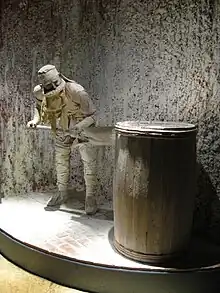
Grassing is one of the oldest methods of bleaching textile goods. The grassing method has been long been used in Europe to bleach linen and cotton based fabrics.[1]
Method
The linens were laid out on the grass for over seven days after boiling with the ''lyes of ashes and rinsing''.[2] The atmospheric oxygen and the oxygen left by the grass provide the whitening action. The cloth becomes whiter day by day until it attains the full whiteness. It was a slow process, but safer for the subjected material. Chemical bleaching may harm the cloth, but in the grassing it hardly affects the cloth's strength.[1][3][4]
Bleachfield
The Bleachfield was an open area to spread cloth. It was a field near the watercourse used by a bleachery. Bleachfields were common in and around the mill towns during the British Industrial Revolution[5]
Chemical bleaching
With the discovery of Chlorine in the late 18th century, chemical bleaching took over from grassing, as it was quicker and could be done indoors.[1][5][2]
Oxygen bleaching action
It is the conjugated double bonds of the substrate that makes the substrate capable of absorbing visible light. The absorption of light makes the cloth look yellowish. Bleaching with oxygen removes the chromophoric sites and makes the cloths whiter. Oxygen is a degrading bleaching agent. Its bleaching action is based on ''destroying the phenolic groups and the carbon–carbon double bonds.''.[6] A major source of chemical bleaching is hydrogen peroxide (H
2O
2) that contains a single bond, (–O–O–). When the bond breaks, it gives rise to very reactive oxygen specie, which is the active agent of the bleach. Around sixty percent of the world's hydrogen peroxide is used in chemical bleaching of textiles and wood pulp.[7]
Gallery
 Early method of bleaching cotton and linen goods on lawns
Early method of bleaching cotton and linen goods on lawns.jpg.webp) Linen Bleaching/ Grassing
Linen Bleaching/ Grassing Bleaching Ground
Bleaching Ground_and_Joos_de_Momper_(II)_-_Market_and_washing_place_in_Flanders.jpg.webp) Market and washing place in Flanders
Market and washing place in Flanders A bleach worker
A bleach worker.tiff.jpg.webp) Bleaching vats for cloth in the piece.
Bleaching vats for cloth in the piece. High Pressure Blow-through Kier
High Pressure Blow-through Kier
See also
References
- 1 2 3 Nystrom, Paul Henry (1916). Textiles. D. Appleton. p. 266.
Grassing . — The oldest bleaching method is that of " grassing , " still used to a certain extent in Europe for bleaching linens. The linen fabrics are laid on the grass or ground for weeks . The oxygen of the air and that given off by green plants
- 1 2 Sansone, Antonio (1888). Dyeing: Comprising the Dyeing and Bleaching of Wool, Silk, Cotton, Flax, Hemp, China Grass &c. A. Heywood & son. p. 109.
- ↑ Fraser, Grace Lovat (1948). Textiles by Britain. G. Allen & Unwin. p. 136.
- ↑ England), Textile Institute (Manchester (1923). Journal of the Textile Institute. The Institute. p. 125.
- 1 2 Aspin, C. (Christopher) (1981). The cotton industry. Internet Archive. Aylesbury : Shire Publications Ltd. p. 24. ISBN 978-0-85263-545-2.
- ↑ "Bleaching Agent - an overview | ScienceDirect Topics". www.sciencedirect.com. Retrieved 2021-07-27.
- ↑ Hage, Ronald; Lienke, Achim (2006). "Applications of Transition-Metal Catalysts to Textile and Wood-Pulp Bleaching". Angewandte Chemie International Edition. 45 (2): 206–222. doi:10.1002/anie.200500525. ISSN 1521-3773. PMID 16342123.